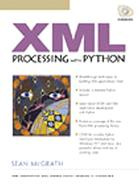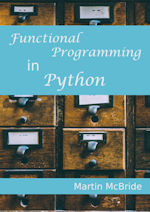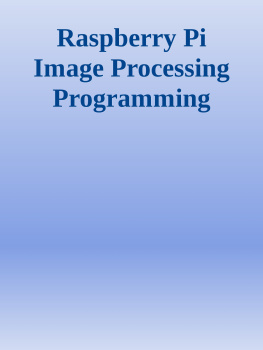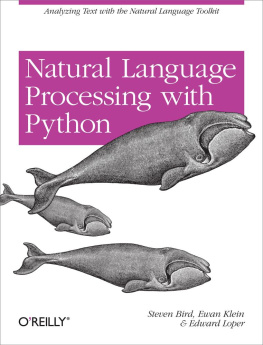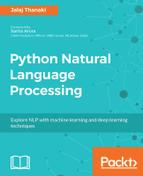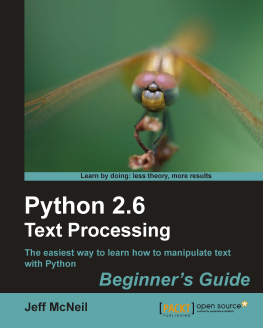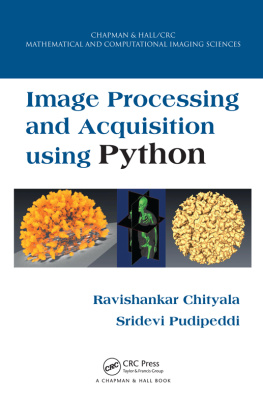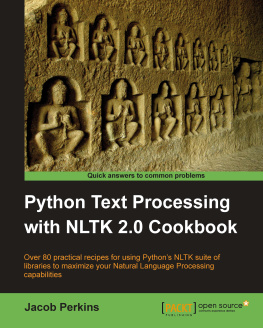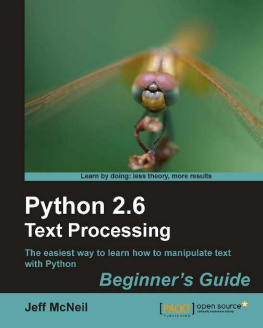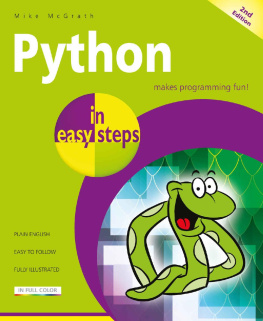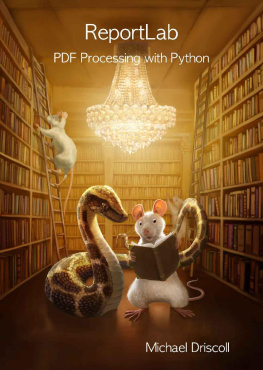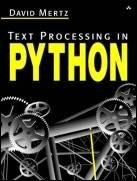Sean McGrath - XML processing with Python
Here you can read online Sean McGrath - XML processing with Python full text of the book (entire story) in english for free. Download pdf and epub, get meaning, cover and reviews about this ebook. year: 2018, publisher: Prentice Hall, genre: Computer. Description of the work, (preface) as well as reviews are available. Best literature library LitArk.com created for fans of good reading and offers a wide selection of genres:
Romance novel
Science fiction
Adventure
Detective
Science
History
Home and family
Prose
Art
Politics
Computer
Non-fiction
Religion
Business
Children
Humor
Choose a favorite category and find really read worthwhile books. Enjoy immersion in the world of imagination, feel the emotions of the characters or learn something new for yourself, make an fascinating discovery.
- Book:XML processing with Python
- Author:
- Publisher:Prentice Hall
- Genre:
- Year:2018
- Rating:5 / 5
- Favourites:Add to favourites
- Your mark:
- 100
- 1
- 2
- 3
- 4
- 5
XML processing with Python: summary, description and annotation
We offer to read an annotation, description, summary or preface (depends on what the author of the book "XML processing with Python" wrote himself). If you haven't found the necessary information about the book — write in the comments, we will try to find it.
XML processing with Python — read online for free the complete book (whole text) full work
Below is the text of the book, divided by pages. System saving the place of the last page read, allows you to conveniently read the book "XML processing with Python" online for free, without having to search again every time where you left off. Put a bookmark, and you can go to the page where you finished reading at any time.
Font size:
Interval:
Bookmark:
Library of Congress Cataloging-in-Publication Data
McGrath, Sean
XML processing with Python / Sean McGrath.
p. cm.
ISBN 0-13-021119-2 (pbk.)
1. XML (Document markup language) 2. Python (computer program language) I. Title.
QA76.76.H94 M3885 2000
005.7'2--dc21
00-026326
Editorial/Production Supervision: Patti Guerrieri
Acquisitions Editor: Mark L. Taub
Editorial Assistant: Michael Fredette
Marketing Manager: Kate Hargett
Manufacturing Manager: Alexis R. Heydt
Cover Design: Anthony Gemmellaro
Cover Design Direction: Jerry Votta
Series Design: Gail Cocker-Bogusz
2000 Prentice Hall PTR
Prentice-Hall, Inc.
Upper Saddle River, Ny 07458
Prentice Hall books are widely used by corporations and government agencies for training, marketing, and resale.
The publisher offers discounts on this book when ordered in bulk quantities. For more information, contact: Corporate Sales Department. Phone: 800-382-3419; FAX: 201-236-7141; E-mail: ; or write to: Prentice Hall PTR, Corp. Sales Dept., One Lake Street, Upper Saddle River, NJ 07458.
All rights reserved. No part of this book may be reproduced, in any form or by any means, without permission in writing from the publisher.
Printed in the United States of America
10 9 8 7 6 5 4 3 2 1
Prentice-Hall International (UK) Limited, London
Prentice-Hall of Australia Pty. Limited, Sydney
Prentice-Hall Canada, Inc., Toronto
Prentice-Hall Hispanoamericana, S.A., Mexico
Prentice-Hall of India Private Limited, New Delhi
Prentice-Hall of Japan, Inc., Tokyo
Pearson Education Asia Pte. Ltd.
Editora Prentice-Hall do Brasil, Ltda., Rio de Janeiro
Names such as company names, trade names, font names, service names, and product names appearing in this book may be registered or unregistered trademarks or service marks, whether or not identified as such. All such names and all registered and unregistered trademarks, service marks, and logos appearing in this book or on its cover are used for identification purposes only and are the property of their respective owners.
Series logo by Andrew Goldfarb for EyeTech Graphics, copyright 1996, 1998 Andrew Goldfarb.
Series Foreword and book Foreword copyright 1998, 2000 Charles F. Goldfarb.
Opinions expressed in this book are those of the Author and are not necessarily those of the Publisher or Series Editor.
The Author of this book has included a diskette or CD-ROM of related materials as a convenience to the reader. The Series Editor did not participate in the preparation, testing, or review of the materials and is not responsible for their content.

Open Information Management (OIM) means managing information so that it is open to processing by any program, not just the program that created it. That extends even to application programs not conceived of at the time the information was created.
OIM is based on the principle of data independence: data should be stored in computers in non-proprietary, genuinely standardized representations. And that applies even when the data is the content of a document. Its representation should distinguish the innate information from the proprietary codes of document processing programs and the artifacts of particular presentation styles.
Business data baseswhich rigorously separate the real data from the input forms and output reportsachieved data independence decades ago. But documents, unlike business data, have historically been created in the context of a particular output presentation style. So for document data, independence was largely unachievable until recently.
That is doubly unfortunate. It is unfortunate because documents are a far more significant repository of humanity's information. And documents can contain significantly richer information structures than data bases.
It is also unfortunate because the need for OIM of documents is greater now than ever. The demands of repurposing require that information be deliverable in multiple formats: paper-based, online, multimedia, hypermedia. And information must now be delivered through multiple channels: traditional bookstores and libraries, the World Wide Web, corporate intranets and extranets. In the latter modes, what starts as data base data may become a document for browsing, but then may need to be reused by the reader as data.
Fortunately, in the past ten years a technology has emerged that extends to documents the data base's capacity for data independence. And it does so without the data base's restrictions on structural freedom. That technology is the Standard Generalized Markup Language (SGML), an official International Standard (ISO 8879) that has been adopted by the world's largest producers of documents and by the World Wide Web.
With SGML, organizations in government, aerospace, airlines, automotive, electronics, computers, and publishing (to name a few) have freed their documents from hostage relationships to processing software. SGML coexists with graphics, multimedia, and other data standards needed for OIM and acts as the framework that relates objects in the other formats to one another and to SGML documents.
The World Wide Web's HTML and XML are both based on SGML. HTML is a particular, though very general, application of SGML, like those for the above industries. There is a limited set of markup tags that can be used with HTML. XML, in contrast, is a simplified subset of SGML facilities that, like full SGML, can be used with any set of tags. You can literally create your own markup language with XML.
As the enabling standard for OIM of documents, the SGML family of standards necessarily plays a leading role in this series. We provide tutorials on SGML, XML, and other key standards and the techniques for applying them. Our books vary in technical intensity from programming techniques for software developers to the business justification of OIM for enterprise executives. We share the practical experience of organizations and individuals who have applied the techniques of OIM in environments ranging from immense industrial publishing projects to websites of all sizes.
Our authors are expert practitioners in their subject matter, not writers hired to cover a hot topic. They bring insight and understanding that can only come from real-world experience. Moreover, they practice what they preach about standardization. Their books share a common standards-based vocabulary. In this way, knowledge gained from one book in the series is directly applicable when reading another, or the standards themselves. This is just one of the ways in which we strive for the utmost technical accuracy and consistency with the OIM standards.
And we also strive for a sense of excitement and fun. After all, the challenge of OIMpreserving information from the ravages of technology while exploiting its benefitsis one of the great intellectual adventures of our age. I'm sure you'll find this series to be a knowledgeable and reliable guide on that adventure.

As XML is a subset of SGML, the Series List is categorized to show the degree to which a title applies to XML. "XML Titles" are those that discuss XML explicitly and may also cover full SGML. "SGML Titles" do not mention XML per se, but the principles covered may apply to XML.
Goldfarb, Pepper, and Ensign
SGML Buyer's GuideTM: Choosing the Right XML and SGML Products and Services
Font size:
Interval:
Bookmark:
Similar books «XML processing with Python»
Look at similar books to XML processing with Python. We have selected literature similar in name and meaning in the hope of providing readers with more options to find new, interesting, not yet read works.
Discussion, reviews of the book XML processing with Python and just readers' own opinions. Leave your comments, write what you think about the work, its meaning or the main characters. Specify what exactly you liked and what you didn't like, and why you think so.

